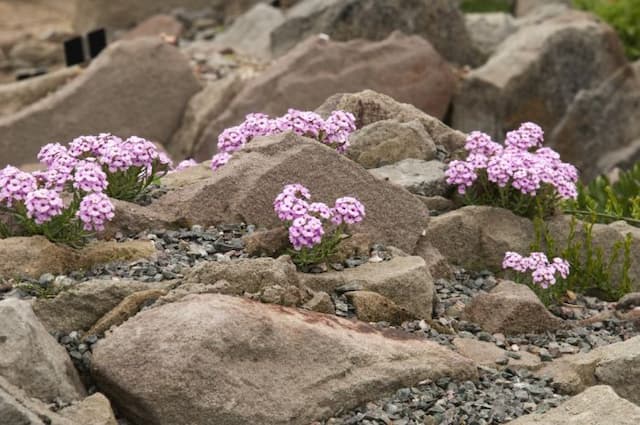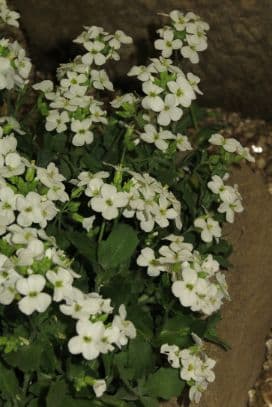Sweet alyssum Lobularia maritima 'Easter Bonnet Lavender'

ABOUT
The plant known as 'Easter Bonnet Lavender' typically features a lush, dense mat of small, oblong to spoon-shaped leaves that are bright green in color, creating an attractive backdrop for the blooms. The delicate flowers are the standout feature of the plant, presenting in shades of soft lavender. They are small and sweet-smelling, clustered together in abundant, rounded heads that provide a frothy appearance. These blossoms are prized for their honey-like fragrance, which can be quite intense and adds to the sensory appeal of the plant. Overall, the plant has a mounding and spreading habit, creating an impression of a gentle wave of color and texture in the garden setting. It is often used as ground cover or as an edging plant because of its shape and the copious blooms that cover the plant throughout the blooming season.
About this plant
 Names
NamesFamily
Brassicaceae
Synonyms
Sweet Alyssum, Sweet Alison, Seaside Lobularia
Common names
Alyssum maritimum, Lobularia maritima
 Toxicity
ToxicityTo humans
Sweet Alyssum is generally considered non-toxic to humans. There are no known significant toxic effects associated with ingesting this plant. However, as with any plant, individual sensitivities and allergic reactions are always possible. If a person were to have an allergic reaction after ingesting or handling Sweet Alyssum, they might experience symptoms such as skin irritation, itching, or gastrointestinal discomfort.
To pets
Sweet Alyssum is also known to be non-toxic to pets. This includes common household pets like dogs and cats. They can typically ingest the plant without any significant risk of poisoning. As with humans, individual pets may have sensitivities or allergic reactions to the plant, which could involve mild gastrointestinal upset or dermatitis, but this is not common. If you suspect your pet is having a reaction to any plant, it is always best to consult with your veterinarian.
 Characteristics
CharacteristicsLife cycle
Annuals
Foliage type
Evergreen
Color of leaves
Green
Flower color
Lavender
Height
0.5 feet (15 cm)
Spread
1 feet (30 cm)
Plant type
Herb
Hardiness zones
9
Native area
Mediterranean
Benefits
 General Benefits
General Benefits- Ornamental Appeal: Adds beautiful lavender-colored flowers to gardens and landscapes.
- Easy to Grow: Known for being low-maintenance and easy to cultivate in a wide range of conditions.
- Long Blooming Period: Produces flowers for an extended period, often throughout the growing season.
- Drought Tolerance: Can withstand periods of dry weather, requiring less frequent watering.
- Attracts Pollinators: Flowers provide nectar for bees, butterflies, and other beneficial insects.
- Compact Growth: Forms a neat, compact mound suitable for borders, edging and containers.
- Ground Cover: Helps suppress weeds by forming a dense mat of foliage.
- Fragrance: The plant emits a pleasant scent that can enhance the sensory experience of a garden.
- Deer Resistance: Generally not preferred by deer, reducing the risk of damage in areas with deer populations.
- Seasonal Flexibility: Thrives in both spring and autumn, offering versatility for garden planning.
- Colorful Foliage: Some varieties have attractive foliage that can add to the visual interest of plantings.
 Medical Properties
Medical PropertiesThis plant is not used for medical purposes.
 Air-purifying Qualities
Air-purifying QualitiesThis plant is not specifically known for air purifying qualities.
 Other Uses
Other Uses- Pressed Flower Art: Lobularia maritima's delicate lavender flowers can be pressed and used in creating floral art pieces, bookmarks, and greeting cards due to their vibrant color and pleasant shape.
- Natural Dye: The flowers of the Sweet Alyssum can be used to produce a natural lavender dye for coloring fabrics, yarn, or paper.
- Photography Prop: Its dense clusters of small flowers serve as an excellent photography backdrop or prop for macro photography, adding a soft and natural touch.
- Educational Tool: Sweet Alyssum is an ideal plant for children’s gardens or educational projects due to its ease of growth and maintenance, making it a great way to teach plant life cycles.
- Petal Confetti: The flowers of Sweet Alyssum can be dried and used as biodegradable confetti for weddings or celebrations, which is environmentally friendly and adds a sweet scent to the occasion.
- Floral Ice Cubes: Add a touch of elegance to beverages by freezing the small blooms within ice cubes for use in punches or cocktails during events.
- Flower Arrangement Filler: Its small flowers and foliage can be used as a delicate filler in live or dried floral arrangements to create texture and fullness.
- Craft Projects: Use Sweet Alyssum in various DIY craft projects, such as creating flower crowns, wreaths, or natural potpourri.
- Garden Aroma: Plant it in areas where you spend time outdoors to enjoy its sweet fragrance, which can be a natural way to enhance relaxation in garden spaces.
- Culinary Garnish: Although not widely known for culinary uses, Sweet Alyssum can be used as an edible garnish to add a hint of color to salads and desserts, ensuring that any plant used is free from pesticides and other chemicals.
Interesting Facts
 Feng Shui
Feng ShuiThe sweet alyssum is not used in Feng Shui practice.
 Zodiac Sign Compitability
Zodiac Sign CompitabilityThe sweet alyssum is not used in astrology practice.
 Plant Symbolism
Plant Symbolism- Innocence - Lobularia maritima, commonly known as Sweet Alyssum, often symbolizes innocence due to its delicate small flowers.
- Beauty - The plant is also associated with beauty, reflecting its abundant, dainty lavender blooms that create a carpet-like appearance.
- Protection - Some cultures believe Sweet Alyssum possesses protective qualities, planting it to ward off negativity and bring good luck.
- Calming - The soothing lavender color of the 'Easter Bonnet Lavender' variety has a calming effect, often used to symbolize peace and tranquility.
 Water
WaterSweet Alyssum should be watered regularly to keep the soil consistently moist but not soggy. Frequent watering is essential during hot, dry periods, which may mean providing about 1 inch of water weekly. Using a watering can or hose with a gentle spray head, water at the base of the plant to avoid wetting the foliage, which can lead to fungal diseases. During the peak summer heat, Sweet Alyssum may need watering twice a week, whereas, in cooler temperatures or cloudy weather, reducing to once per week or when the top inch of soil feels dry to the touch might be adequate.
 Light
LightSweet Alyssum thrives in full sunlight, which means it requires at least 6 hours of direct sunlight daily for optimal growth. The best spot for the plant is an area with unobstructed sun exposure throughout the day. However, in regions with very intense midday sun, some light afternoon shade can be beneficial to prevent scorching.
 Temperature
TemperatureSweet Alyssum prefers moderate temperatures and will grow best when day temperatures are between 60 and 75°F. This plant can survive minimum temperatures down to 40°F and can tolerate a light frost, but it will not survive in extremely high temperatures, particularly above 85°F, where it may begin to languish and could benefit from some shade to cool down.
 Pruning
PruningPruning Sweet Alyssum encourages bushier growth and more blooms. Regularly deadhead spent flowers to promote continuous flowering throughout the season. Pruning can be done every 2 to 3 weeks or as needed when the plant begins to look leggy or when blooming decreases. The best time for more extensive pruning is in late summer to rejuvenate the plants for a fall bloom.
 Cleaning
CleaningAs needed
 Soil
SoilSweet Alyssum prefers well-draining soil enriched with organic matter and a pH of 6.0-7.0. A mix of potting soil, compost, and perlite or sand will promote healthy growth.
 Repotting
RepottingSweet Alyssum typically does not require frequent repotting and can thrive in the same container for several seasons as it is often grown as an annual.
 Humidity & Misting
Humidity & MistingSweet Alyssum is quite adaptable but prefers moderate humidity levels; it does not require any special humidity-related care.
 Suitable locations
Suitable locationsIndoor
Place in bright light, ensure good air flow, and use well-draining soil.
Outdoor
Full sun to part shade, in well-drained soil, and moderate watering.
Hardiness zone
5-9 USDA
 Life cycle
Life cycleLobularia maritima 'Easter Bonnet Lavender', commonly known as Sweet Alyssum, begins its life cycle when seeds are sown in spring after the last frost, or in mild climates, in fall for winter blooms. Upon germination, seedlings emerge and develop into a low-growing foliage mat. The plant then enters a vegetative stage where it produces dense clusters of small, fragrant, lavender flowers that attract pollinators. After flowering, the Sweet Alyssum goes through the reproductive stage where seeds form in small pods, completing the flower-to-seed cycle. If conditions allow, it may self-sow, dropping seeds that germinate and begin a new cycle. In colder climates, the plant behaves as an annual, dying off with the first frost, but in milder regions, it may persist as a perennial or self-seeding biannual.
 Propogation
PropogationPropogation time
Spring to Summer
The most popular method of propagation for Sweet Alyssum, specifically the variety Lobularia maritima 'Easter Bonnet Lavender', is by seed. Sowing can be done in early spring, as soon as the soil can be worked, or started indoors approximately 6 to 8 weeks before the last expected frost. To sow Sweet Alyssum seeds, sprinkle them onto the surface of well-drained soil and lightly press them in. The seeds require light to germinate, so they should not be covered with soil. Keep the soil moist but not waterlogged, and at a temperature between 60-70 degrees Fahrenheit (15.6-21.1 degrees Celsius). Seedlings usually emerge within 7 to 14 days. Once the seedlings have developed a few true leaves and are large enough to handle, they can be transplanted to their final growing positions, spacing them 6 to 9 inches (15 to 23 centimeters) apart.



![Aubrieta [Axcent Light Blue]](/_next/image?url=https%3A%2F%2Fplants-admin.emdemapps.com%2Fimages%2Fplants%2F%2Fimages%2F604b5e7128866.png&w=640&q=75)





